The Sequencing Electrophoresis Systems Market is estimated to be valued at USD 7.2 billion in 2025 and is projected to reach USD 12.8 billion by 2035, registering a compound annual growth rate (CAGR) of 5.9% over the forecast period.
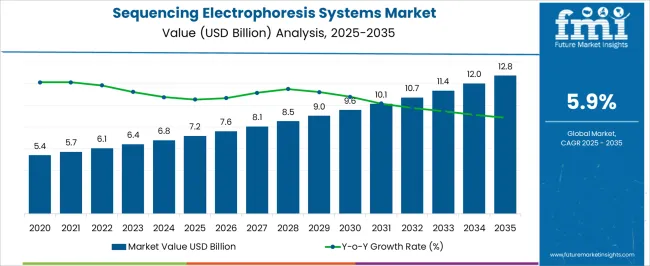
| Metric | Value |
|---|---|
| Sequencing Electrophoresis Systems Market Estimated Value in (2025 E) | USD 7.2 billion |
| Sequencing Electrophoresis Systems Market Forecast Value in (2035 F) | USD 12.8 billion |
| Forecast CAGR (2025 to 2035) | 5.9% |
The Sequencing Electrophoresis Systems market is witnessing steady expansion, driven by growing demand for genetic research, diagnostics, and pharmaceutical applications. The current market scenario reflects the increasing adoption of advanced sequencing technologies in both academic and industrial laboratories. Investment in biotechnology research, increasing prevalence of genetic disorders, and the ongoing focus on precision medicine are shaping the market's future outlook.
Automation of sequencing workflows and the integration of high-throughput analysis have enhanced efficiency and reduced operational costs, making these systems more attractive to researchers and institutions. The rising importance of molecular diagnostics, coupled with the need for accurate and reproducible results, has further contributed to the market growth.
Additionally, the adoption of sequencing systems in pharmaceutical research has been increasing due to their role in drug discovery, biomarker identification, and therapeutic development Overall, the market is expected to continue its growth trajectory as research institutions, diagnostic laboratories, and pharmaceutical companies prioritize accuracy, throughput, and flexibility in sequencing applications.
The sequencing electrophoresis systems market is segmented by type, application, and geographic regions. By type, sequencing electrophoresis systems market is divided into Glass Sequencing Electrophoresis Systems and Plastic Sequencing Electrophoresis Systems. In terms of application, sequencing electrophoresis systems market is classified into Pharmaceutical, Microbiology, Chemical, Bio-chemical, Nanotechnology, and Other Application Areas. Regionally, the sequencing electrophoresis systems industry is classified into North America, Latin America, Western Europe, Eastern Europe, Balkan & Baltic Countries, Russia & Belarus, Central Asia, East Asia, South Asia & Pacific, and the Middle East & Africa.
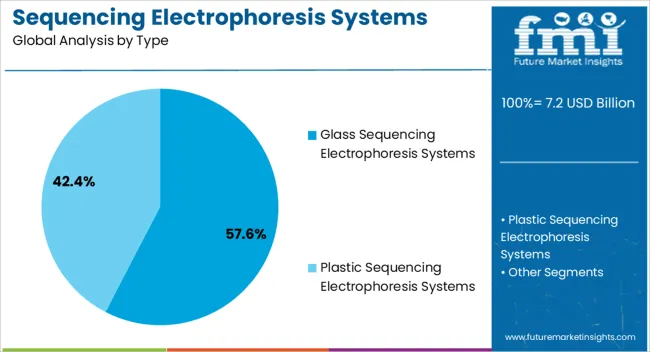
The Glass Sequencing Electrophoresis Systems segment is projected to hold 57.60% of the total market revenue in 2025, making it the leading type in the market. This dominance is being attributed to the high precision and reproducibility offered by glass-based systems, which are critical for sensitive genetic and protein analysis. Adoption has been driven by the need for accurate separation of nucleic acids and proteins, where resolution and reliability directly influence research outcomes.
The modular design of these systems allows flexible integration into laboratory workflows and supports upgrades without complete hardware replacement. Furthermore, the chemical and thermal stability of glass ensures long-term usability, reducing maintenance and operational challenges in high-throughput laboratories.
Demand has been further strengthened by the emphasis on quality and consistency in pharmaceutical research, particularly in genomics, proteomics, and molecular diagnostics As laboratories continue to prioritize accurate and reproducible results, the Glass Sequencing Electrophoresis Systems segment is expected to retain its market leadership due to its combination of durability, performance, and adaptability.
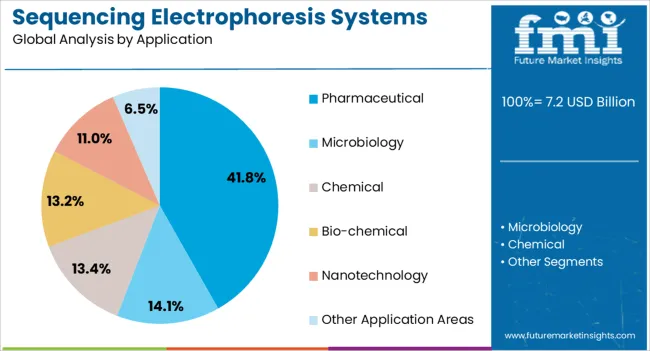
The Pharmaceutical application segment is anticipated to capture 41.80% of the total market revenue in 2025, emerging as the dominant application area. This leadership is being driven by the increasing reliance on sequencing technologies for drug discovery, genetic screening, and biomarker validation.
Adoption has been accelerated by the growing need for high-throughput and accurate systems that support rapid identification of genetic variations and protein interactions, which are critical for therapeutic development. The integration of sequencing electrophoresis systems into pharmaceutical research workflows has enhanced efficiency and reduced turnaround time for experiments, making these systems indispensable in modern laboratories.
Moreover, regulatory emphasis on reproducibility and precision in pharmaceutical research has favored the use of high-performance systems capable of generating reliable data As pharmaceutical companies continue to invest in genomics-based drug development, biomarker research, and personalized medicine, the Pharmaceutical application segment is expected to maintain its leading share, supported by robust performance, ease of integration, and adaptability of sequencing electrophoresis systems to evolving research needs.
Advancements in micro-channel sequencing electrophoresis systems for the purpose of deoxyribonucleic acid analysis play a major role in the fields of biomedical and biological sciences. In the new era of genomic science, technological advancements in sequencing electrophoresis systems offer a new set of benefits. These benefits are expected to result in a continuous increase in genotyping and sequencing throughput and efficiency. High resolution size and/or conformation-based electrophoretic separation of deoxyribonucleic acid is the most critical step, and it cannot be performed manually. Sequencing electrophoresis systems can perform these tasks for the purpose of genetic analysis.
The continued progress in the biology research and instrumentation field is estimated to have a positive impact on the growth of the global sequencing electrophoresis systems market. The availability of specialised sequencing electrophoresis systems for different cell cultures and sample studies is also expected to boost the global market. Suppliers that offer sequencing electrophoresis systems with enhanced durability are also expected to accommodate the overall growth of the global market.
In addition, companies that are investing heavily in bio-chemical and chemical research areas, which are estimated to be the primary drivers of the global sequencing electrophoresis systems market. The high adoption of sequencing electrophoresis systems for bio-chemical and microbiology research is expected to provide a significant boost to the global market during the forecast period. Moreover, increase in the utilisation of specialised sequencing electrophoresis systems in nanotechnology, bio-chemical & bio-medical, geology and pharmaceutical industries is also expected to enable the global sequencing electrophoresis systems market to continue to grow at a steady rate. The elimination of the re-usability factor in plastic sequencing electrophoresis systems is expected to enhance the sales of such these systems.
However, the delicate nature of these systems is expected to restrict the growth of the overall sequencing electrophoresis systems market during the forecast period. Moreover, if adequate precautions are taken to protect the glass sequencing electrophoresis systems from damage, they can be re-used for a long time. This factor is also expected to hamper the growth of the global market.
At present, laboratories focused on microbiology research report are the largest adopters of sequencing electrophoresis systems among all the application areas. However, pharmaceutical laboratories are expected to register the highest adoption rate of these systems during the forecast period.
The presence of a large number of manufacturers and suppliers of sequencing electrophoresis systems in the North American market is expected to be among the primary drivers of the sequencing electrophoresis systems market in the region. At present, the market in North America holds the largest share of the global market. The manufacturers of laboratory-grade sequencing electrophoresis systems in the Asia Pacific economies are heavily investing in the laboratory instrumentation field. This factor is estimated to boost the Asia Pacific sequencing electrophoresis systems market during the forecast period. The markets in the Middle East and Africa region and the Latin America region are also expected to register high growth rates during the forecast period owing to a continuous increase in the adoption of sequencing electrophoresis systems for biological research purposes.
The report is a compilation of first-hand information, qualitative and quantitative assessment by industry analysts, inputs from industry experts and industry participants across the value chain. The report provides in-depth analysis of parent market trends, macro-economic indicators and governing factors along with market attractiveness as per segments. The report also maps the qualitative impact of various market factors on market segments and geographies.
The global demand for DNA sequencing electrophoresis systems is forecast to grow at a healthy CAGR of around 6% to 6.2% during the forecast period from 2025 to 2035. Growth in the market is driven by rising applications of DNA sequencing electrophoresis systems in fields like microbiology, biochemistry, and pharmaceuticals.
Advances in medical and biological fields along with complexity associated with various techniques have prompted researchers to employ fast and effective technologies in processes like DNA sequencing. This factor has brought DNA sequencing electrophoresis systems into the limelight.
DNA sequencing electrophoresis systems have become essential equipment for performing electrophoresis, a special technique for separating DNA, RNA and protein based on their size, mass or electrical charge. The technique involves running a current through a gel containing molecules of interest.
Electrophoretic separation of DNA is the most critical step in many genetic analyses. Adoption of DNA sequencing electrophoresis systems increases sequencing and genotyping efficiency and throughput, as well as decreases the overall analysis costs. Advances in microchannel electrophoretic systems for DNA analyses have had important impacts on biomedical and biological sciences and the trend is likely to escalate during the forthcoming period.
The robust expansion of DNA sequencing electrophoresis systems market is attributable to the advancement in biology research and instrumentation fields, rising prevalence of various chronic and infectious diseases, increasing investments in research and development, advancements in medical technologies, and availability of specialized systems for different cell cultures and sample studies.
DNA sequencing electrophoresis systems have become ideal tools used during DNA analysis and medical research activities for separating DNA and protein on the basis of their size and electrical charge. They provide better accuracy, high speed, and precise results, thereby making them ideal for usage in genome analysis.
Increasing investments by companies in chemical and bio-chemical research areas is expected to generate lucrative sales prospects for DNA sequencing electrophoresis systems during the forecast period. DNA sequencing electrophoresis systems are being increasingly used during microbiology and bio-chemical research activities
Similarly, rising adoption of specialised DNA sequencing electrophoresis systems in bio-medical, nanotechnology, and pharmaceutical industries is expected to boost market growth during the forthcoming period.
Additionally, rising government initiatives and funding for research on genomics and proteomics along with advancements in electrophoresis systems will further generate sales prospects for DNA sequencing electrophoresis systems during the assessment period.
Despite its optimistic stance there are several factors that are likely to limit the growth of DNA sequencing electrophoresis systems market during the forecast period. Some of these factors are the delicate nature of CNA sequencing electrophoresis and higher cost of these systems.
In addition to this, reuse of glass-based DNA sequencing electrophoresis systems for a longer period of time is also anticipated to affect the overall demand over the assessment period.
As per FMI, North America currently accounts for the largest market share of the global DNA sequencing electrophoresis systems market and is expected to grow at a robust CAGR over the forecast period between 2025 and 2035. Growth in the market is driven by increasing biological research activities, rising prevalence of chronic disease, growing adoption of DNA sequencing in biological and medical research, and heavy presence of leading manufacturers and suppliers.
The United States remains at the epicenter of DNA sequencing electrophoresis systems market growth, owing to the large presence of clinical, forensics and research laboratories, favorable government support, advancements in medical technologies, and growing adoption of DNA sequencing electrophoresis systems in the field of genomics, proteomics, drug discovery and personalized medicine.
According to Future Market Insights, the Asia Pacific market is expected to witness significant growth during the forecast period, owing to the increasing investments by manufactures in the laboratory instrumentation field, rising penetration of foreign market players, favorable government support, and increase in proteomic and genomics research in countries like China.
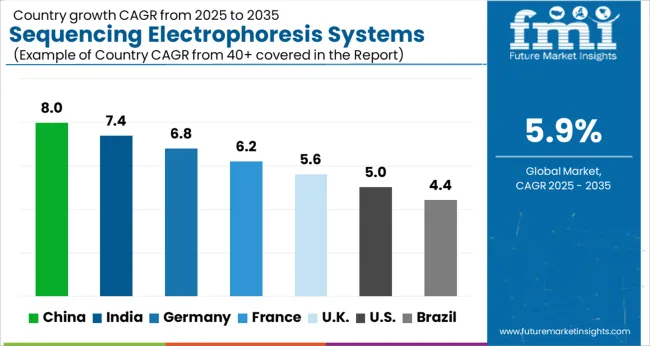
| Countries | CAGR |
|---|---|
| China | 8.0% |
| India | 7.4% |
| Germany | 6.8% |
| France | 6.2% |
| UK | 5.6% |
| USA | 5.0% |
| Brazil | 4.4% |
The Sequencing Electrophoresis Systems Market is expected to register a CAGR of 5.9% during the forecast period, exhibiting varied country level momentum. China leads with the highest CAGR of 8.0%, followed by India at 7.4%. Developed markets such as Germany, France, and the UK continue to expand steadily, while the USA is likely to grow at consistent rates. Brazil posts the lowest CAGR at 4.4%, yet still underscores a broadly positive trajectory for the global Sequencing Electrophoresis Systems Market. In 2024, Germany held a dominant revenue in the Western Europe market and is expected to grow with a CAGR of 6.8%.
The USA Sequencing Electrophoresis Systems Market is estimated to be valued at USD 2.7 billion in 2025 and is anticipated to reach a valuation of USD 4.4 billion by 2035. Sales are projected to rise at a CAGR of 5.0% over the forecast period between 2025 and 2035. While Japan and South Korea markets are estimated to be valued at USD 334.4 million and USD 214.7 million respectively in 2025.
Some of the key participants present in the global DNA sequencing electrophoresis systems market include Normax, Thermo Fisher Scientific Inc., Corning Incorporated, BRAND GMBH + CO KG, Deltalab, Paul Marienfeld GmbH & Co. KG, DWK Life Sciences, FL MEDICAL s.r.l., CML Biotech and Boekel Scientific among others.
Most of these players are continuously introducing advanced systems with additional features to increase their sales. Besides this, they are aiming at expanding their presence across emerging economies like Asia Pacific and the Middle East through strategies like new facility establishments, partnerships, acquisitions etc.
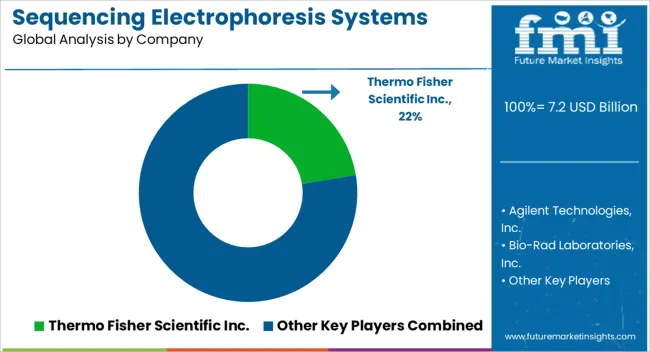
| Item | Value |
|---|---|
| Quantitative Units | USD 7.2 Billion |
| Type | Glass Sequencing Electrophoresis Systems and Plastic Sequencing Electrophoresis Systems |
| Application | Pharmaceutical, Microbiology, Chemical, Bio-chemical, Nanotechnology, and Other Application Areas |
| Regions Covered | North America, Europe, Asia-Pacific, Latin America, Middle East & Africa |
| Country Covered | United States, Canada, Germany, France, United Kingdom, China, Japan, India, Brazil, South Africa |
| Key Companies Profiled | Thermo Fisher Scientific Inc., Agilent Technologies, Inc., Bio-Rad Laboratories, Inc., QIAGEN N.V., Beckman Coulter, Inc., PerkinElmer, Inc., Merck KGaA, Promega Corporation, Lonza Group Ltd., and Harvard Bioscience, Inc. |
The global sequencing electrophoresis systems market is estimated to be valued at USD 7.2 billion in 2025.
The market size for the sequencing electrophoresis systems market is projected to reach USD 12.8 billion by 2035.
The sequencing electrophoresis systems market is expected to grow at a 5.9% CAGR between 2025 and 2035.
The key product types in sequencing electrophoresis systems market are glass sequencing electrophoresis systems and plastic sequencing electrophoresis systems.
In terms of application, pharmaceutical segment to command 41.8% share in the sequencing electrophoresis systems market in 2025.






Full Research Suite comprises of:
Market outlook & trends analysis
Interviews & case studies
Strategic recommendations
Vendor profiles & capabilities analysis
5-year forecasts
8 regions and 60+ country-level data splits
Market segment data splits
12 months of continuous data updates
DELIVERED AS:
PDF EXCEL ONLINE
DNA Sequencing Electrophoresis Systems Market
Sequencing and Spatial Omics Platform Market Size and Share Forecast Outlook 2025 to 2035
Sequencing Reagents Market
DNA Sequencing Services Market Trends - Growth & Forecast 2025 to 2035
mRNA Sequencing Market - Growth & Forecast 2025 to 2035
Tumor-sequencing Blood Testing Market
Glycan Sequencing Market
Aircraft Sequencing System Market Growth – Trends & Forecast 2018-2027
Short-read Sequencing Market by Product, Workflow, and Region from 2025 to 2035
Whole Plasmid Sequencing Market Growth – Innovations, Trends & Forecast 2025-2035
Clinical Next-Generation Sequencing (NGS) Data Analysis Market Analysis by Solution and Services, Technology, End User, and Region through 2035
Chromatin Immunoprecipitation Sequencing Market Size and Share Forecast Outlook 2025 to 2035
Clinical Oncology Next-generation Sequencing Market Analysis - Size, Share, and Forecast 2025 to 2035
Electrophoresis Reagents Market Size and Share Forecast Outlook 2025 to 2035
Electrophoresis Market Trends - Growth, Demand & Forecast 2025 to 2035
Electrophoresis Equipment and Supplies Market Analysis
Electrophoresis Transilluminator Market
Microchip Electrophoresis Market Size and Share Forecast Outlook 2025 to 2035
Capillary Electrophoresis Market Size, Growth, and Forecast 2025 to 2035
Nucleic acid electrophoresis and blotting market

Thank you!
You will receive an email from our Business Development Manager. Please be sure to check your SPAM/JUNK folder too.
Chat With
MaRIA